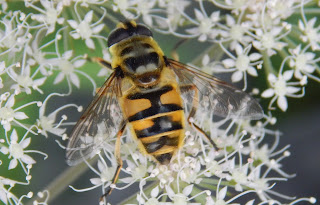 |
| Dead Head Hoverfly (Myathropa florea) |
So, here are the facts:
- Now, I want to get one thing straight right away, their name. Dead Head Hoverflies. Why?
 |
| Here the dead head looks like its joined to a skeleton |
- Well, it's because if you look at their back, the section behind the eyes and where the wings join on, they have what looks like a Head. It doesn't look very 'alive' in fact it looks like a black skull. So that's where they get their name.
- Their wingspan is about 14mm and the are about the same length as a Drone fly, so about 15mm.
- They have what's probably one of the shortest lifespans that I have encountered in my blog. Only about 3 - 4 weeks.
- They are found most commonly in England, not so much in Wales. They get less common in Scotland and the further North you go.
 |
| Feeding on the umbel of a hogweed |
- There aren't many records for Ireland so they are either less common (the less likely option as they are found on the Isle of Wight) or there aren't records of them being there.
- Dead Head Hoverflies like wooded areas and large umbelliferous (great word) flowers, so the Silton Forest with all of the hogweed is ideal for them.
- The larvae develop in stagnant water found in rotting tree stumps, probably the most fussy-about-their-home insect that I have covered so far as well!
- You can see these hoverflies from May through to October with their peak season being July-August.
 |
| Close up of one feeding |
- On Hoverflies in general, the Dead Head is one of over 250 species of Hoverfly in the UK, Up to 85 species have been found in just one garden according to the Royal Entomological Society!
- Hoverflies, when the need to get away from a predator, can actually fly in bursts of 40 kilometres per hour!
- Also on the subject of predatory defences, they have yellow and black stripes, these are used to warn off predators who think that they are a bee or a wasp.
Here are some links to some more information:
Hope you enjoyed,
Z.
Amazing shots here Zach, you've captured the detail on their heads and eyes beautifully. - Tasha
ReplyDelete